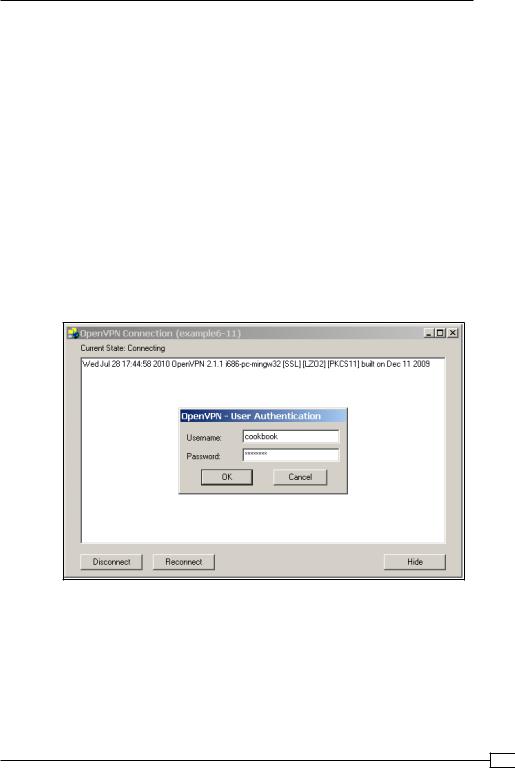
- •Credits
- •About the Author
- •About the Reviewers
- •www.PacktPub.com
- •Table of Contents
- •Preface
- •Introduction
- •Shortest setup possible
- •OpenVPN secret keys
- •Multiple secret keys
- •Plaintext tunnel
- •Routing
- •Configuration files versus the command-line
- •Complete site-to-site setup
- •3-way routing
- •Introduction
- •Setting up the public and private keys
- •Simple configuration
- •Server-side routing
- •Routing: subnets on both sides
- •Redirecting the default gateway
- •Using an 'ifconfig-pool' block
- •Using the status file
- •Management interface
- •Proxy-arp
- •Introduction
- •Simple configuration—non-bridged
- •Enabling client-to-client traffic
- •Bridging—Linux
- •Bridging—Windows
- •Checking broadcast and non-IP traffic
- •External DHCP server
- •Using the status file
- •Management interface
- •Introduction
- •Certificate generation
- •xCA: a GUI for managing a PKI (Part 1)
- •xCA: a GUI for managing a PKI (Part 2)
- •OpenSSL tricks: x509, pkcs12, verify output
- •Revoking certificates
- •The use of CRLs
- •Checking expired/revoked certificates
- •Intermediary CAs
- •Multiple CAs: stacking, using --capath
- •Introduction
- •Initializing a hardware token
- •Getting a hardware token ID
- •Using a hardware token
- •Selecting a PKCS#11 certificate using the management interface
- •Generating a key on the hardware token
- •Private method for getting a PKCS#11 certificate
- •Pin caching example
- •Introduction
- •Using a client-side up/down script
- •Windows login greeter
- •Using client-connect/client-disconnect scripts
- •Using a 'learn-address' script
- •Using a 'tls-verify' script
- •Using an 'auth-user-pass-verify' script
- •Script order
- •Script security and logging
- •Using the 'down-root' plugin
- •Using the PAM authentication plugin
- •Introduction
- •Cipher mismatches
- •TUN versus TAP mismatches
- •Compression mismatches
- •Key mismatches
- •Troubleshooting MTU and tun-mtu issues
- •Troubleshooting network connectivity
- •How to read the OpenVPN log files
- •Introduction
- •The missing return route
- •Missing return routes when 'iroute' is used
- •Source routing
- •Routing and permissions on Windows
- •Troubleshooting client-to-client traffic routing
- •Understanding the 'MULTI: bad source' warnings
- •Failure when redirecting the default gateway
- •Introduction
- •Optimizing performance using 'ping'
- •OpenSSL cipher speed
- •Compression tests
- •Traffic shaping
- •Tuning UDP-based connections
- •Tuning TCP-based connections
- •Analyzing performance using tcpdump
- •Introduction
- •Linux: using NetworkManager
- •MacOS: using Tunnelblick
- •Windows Vista/7: elevated privileges
- •Windows: using the CryptoAPI store
- •Windows: updating the DNS cache
- •Windows: running OpenVPN as a service
- •Windows: public versus private network adapters
- •Windows: routing methods
- •Introduction
- •Including configuration files in config files
- •Details of ifconfig-pool-persist
- •Connecting using a SOCKS proxy
- •Connecting via an HTTP proxy
- •Connecting via an HTTP proxy with authentication
- •Using dyndns
- •IP-less setups (ifconfig-noexec)
- •Introduction
- •Inline certificates
- •Connection blocks
- •Port sharing with an HTTPS server
- •Routing features: redirect-private, allow-pull-fqdn
- •OCSP support
- •New for 2.2: the 'x509_user_name' parameter
- •Index

Chapter 6
There's more...
Plugins are supported on Linux, Net/FreeBSD, and on Windows. The following script callbacks can be intercepted using a plugin:
up
down
route-up
ipchange
tls-verify
auth-user-pass-verify
client-connect
client-disconnect
learn-address
See also
The next recipe, Using the PAM authentication plugin, which explains how to use an OpenVPN plugin to authenticate remote VPN clients.
Using the PAM authentication plugin
A very useful plugin for OpenVPN is a plugin to validate a username using the Linux/UNIX PAM authentication system. PAM stands for Pluggable Authentication Modules and is a very modular system for allowing users access to system resources. It is used by most modern
Linux and UNIX variants, offering a very flexible and extendible system for authenticating and authorizing users. In this recipe, we will use the PAM authentication plugin as a replacement of an auth-user-pass-verify script to validate a remote user's credentials against the system PAM configuration.
Getting ready
Set up the client and server certificates using the first recipe from Chapter 2, Client-server IP-only Networks. For this recipe, the server computer was running CentOS 5 Linux and OpenVPN 2.1.1. The client was running Windows 2000 and OpenVPN 2.1.1.
183

Scripting and Plugins
How to do it...
1.Create the server configuration file:
proto udp port 1194 dev tun
server 192.168.200.0 255.255.255.0
ca |
/etc/openvpn/cookbook/ca.crt |
cert |
/etc/openvpn/cookbook/server.crt |
key |
/etc/openvpn/cookbook/server.key |
dh |
/etc/openvpn/cookbook/dh1024.pem |
tls-auth /etc/openvpn/cookbook/ta.key 0
persist-key persist-tun keepalive 10 60
topology subnet
user nobody
group nobody # nogroup on some distros
daemon
log-append /var/log/openvpn.log
verb 5 suppress-timestamps
plugin /etc/openvpn/cookbook/openvpn-auth-pam.so "login login USERNAME password PASSWORD"
Note that the last line of the server configuration file is a single line. Save it as example6-10-server.conf.
2.Start the OpenVPN server:
[root@server]# openvpn --config example6-10-server.conf
The server log file will now show:
AUTH-PAM: BACKGROUND: INIT service='login'
PLUGIN_INIT: POST /etc/openvpn/cookbook/openvpn-auth-pam.so '[/etc/openvpn/cookbook/openvpn-auth-pam.so] [login] [login] [USERNAME] [password] [PASSWORD]' intercepted=PLUGIN_AUTH_USER_ PASS_VERIFY
This indicates that the PAM plugin successfully initialized in the background.
 184
184

Chapter 6
3.Next, create the client configuration file:
client proto udp
remote openvpnserver.example.com port 1194
dev tun nobind
ca |
"c:/program files/openvpn/config/ca.crt" |
cert |
"c:/program files/openvpn/config/client1.crt" |
key |
"c:/program files/openvpn/config/client1.key" |
tls-auth "c:/program files/openvpn/config/ta.key" 1
auth-user-pass
Save it as example6-10.ovpn.
4.Start the OpenVPN client. The OpenVPN GUI on Windows will first prompt for the Auth username and password:
On the server used in this recipe, a special user cookbook was created. After typing in the username and password, the connection to the server is successfully established. The OpenVPN server log shows:
AUTH-PAM: BACKGROUND: received command code: 0 AUTH-PAM: BACKGROUND: USER: cookbook
AUTH-PAM: BACKGROUND: my_conv[0] query='login:' style=2
AUTH-PAM: BACKGROUND: name match found, query/match-string ['login:', 'login'] = 'USERNAME'
185

Scripting and Plugins
AUTH-PAM: BACKGROUND: my_conv[0] query='Password: ' style=1
AUTH-PAM: BACKGROUND: name match found, query/match-string ['Password: ', 'password'] = 'PASSWORD'
…openvpnclient:50887 PLUGIN_CALL: POST /etc/openvpn/cookbook/openvpn- auth-pam.so/PLUGIN_AUTH_USER_PASS_VERIFY status=0
…openvpnclient:50887 TLS: Username/Password authentication succeeded for username 'cookbook'
This shows that the user was successfully authenticated using PAM.
How it works...
The PAM authentication plugin intercepts the auth-user-pass-verify callback. When the OpenVPN client connects and passes along the username and password, the plugin wakes up. It queries the PAM subsystem by looking at the "login" module (this is the first parameter for the openvpn-auth-pam.so file). The other parameters are used by the auth-pam plugin to know which input to expect from the PAM subsystem:
login USERNAME password PASSWORD
The PAM "login" subsystem will ask for the username by presenting the prompt "login" and will ask for the password by presenting the prompt "password". The auth-pam plugin uses this information to know where to fill in the username (USERNAME) and password (PASSWORD).
After the user has been successfully authenticated by the PAM subsystem, the connection is established.
There's more...
It would also have been possible to authenticate a user using an 'auth-user-pass-verify' script, which queries the PAM subsystem. There are two major advantages to using the PAM plugin for this:
It is not required to use the 'script-security' directive at all.
The plugin method is much faster and far more scalable. When many users try to connect to the OpenVPN server at the same time, the VPN performance would be greatly affected when using an auth-user-pass-verify script, as for each connecting a user, a separate process needs to be started, during which the OpenVPN's main thread is installed.
See also
The previous recipe, Using the 'down-root' plugin, in which the basics of using OpenVPN plugins are explained.
 186
186
